On March 25, a California condor landed on the North Coast.
Unlike his predecessors, the bird known as No. 746 didn't travel on thermals, using his massive, nearly 10-foot wingspan to soar across the landscape. Instead, the 7-year-old adult male came by plane from an Idaho breeding facility to mentor a new generation of condors as part of a Yurok Tribe-led program to return the endangered species to the northern reaches of its former territory.
For Yurok Tribe Wildlife Department Director Tiana Williams-Claussen, his arrival was profound in ways that even surprised her.
"I think we'd all been looking forward to this day, this event when we bring up these birds that would eventually be released, but it was this mentor bird who first hit me really hard," she says. "He's just a visitor with us, he's not going to be released because he's actually got really important genetics, so he's going to be going back to one of the breeding facilities to contribute once he's done teaching our young whippersnappers how to be down here, but he was literally the first condor to be in Yurok country for over 130 years, which just really struck me."
A Harvard University graduate, Williams-Claussen was just 21 years old and fresh out of college when she returned home to serve her tribe, soon becoming the inaugural member of the department she now heads.
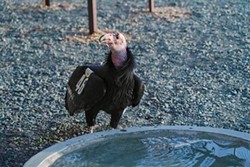
- Photo courtesy of Matt Mais/Yurok Tribe
- Mentor bird No. 746 has the job of teaching the young condors important life skills to help them thrive in the wild.
Most of her adult life has been dedicated to fulfilling a council of Yurok elders' wish to bring back the bird they know as prey-go-neesh to once again soar over the tribe's ancestral lands. Now, 14 years later, the moment was here.
As in many Indigenous cultures, the condor is sacred in Yurok tradition. Believed to be among the Earth's first creatures and the one who carries their prayers to the Creator, the bird also joins in the tribe's World Renewal ceremonies to bring balance back to the world through the gift of feathers, which are used in the dancers' regalia.
While No. 746 will never spiral upward into the heavens like his young charges, Williams-Claussen says he's already made his own contribution, dropping the first locally sourced condor feather to be used for Yurok regalia in more than a century.
"As soon as I really saw him settling in, he immediately felt like family, and it felt like a coming home, " she says.
A few days later, the moment was brought full circle when the rest of the condors arrived — a female and three males tagged respectively as A0, A1, A2 and A3. Joining in the homecoming were tribal elders, including some who made the original decision to return prey-go-neesh to Yurok lands.
That, Williams-Claussen says, was particularly important to her "because without them, none of this would have even happened."
"I'm so just incredibly grateful to these elders for getting the ball rolling, but they were expressing such gratitude to us for making it happen and that was just a really incredible feeling," she says. "I always say we are doing this for the elders, we are doing this for the children, but to actually see what it meant to these folk to come up and actually see condors for the first time was deeply impactful and really brought home the importance of what I was doing."
As part of the welcoming, one of the elders sang a song from the Yurok Tribe's high ceremonies, blessing the condors' arrival and their future.
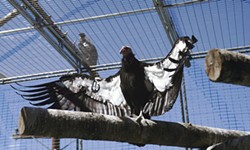
- Photo courtesy of Matt Mais/Yurok Tribe
- The mentor bird opens his wings as A2 sits atop the enclosure.
"There was this really incredible moment when his song is carrying out over the hillside and all the condors, almost exactly at the same time, spread their wings up and kind of turned toward the sound of his voice and, I don't know, from a scientific perspective it could have been that they were just catching that last bit of stray sun, but from the tribal perspective, it just felt like they were really opening up and welcoming the song that they had been blessed with," Williams-Claussen says.
Yurok Tribal Chair Joseph James, whose mother and grandparents passed down the stories of prey-go-neesh to him, describes the condors' return as a "real life manifestation of our cultural commitment to restore and protect the planet for future generations," noting the Yurok people "have upheld a sacred responsibility to maintain balance in the natural world" for countless generations.
Seeing the birds for the first time, James says, made him think of the Yurok elders who are no longer here but worked so hard to make this moment a reality.
"It was beautiful, it was exciting ... It felt like healing to have them back at home," he says.
Not long ago, the California condor was nearly lost to extinction.
Up until March, the last sighting in the North Coast region occurred in 1892. Local populations had been decimated by settlers who poisoned and shot the condors, as well as destroyed habitat and depleted their food supply by overhunting the game and marine mammals on which they depended.
The birds were declared endangered in 1967, with fewer than 100 surviving in the wild. Fewer than two decades later, only 22 remained in a small pocket of mountainous area in Southern California. By 1987, the last of the wild condors were placed into captive breeding programs in a race against time to save the largest bird in North America from extinction.
In the ensuing decades, the overall population slowly increased to include around 500 birds by the end of 2019, with more than half of those in the wild at a scattering of release sites — including Big Sur and Pinnacles — as well as Arizona and Baja California, Mexico.
Now the Yurok-led effort known as the Northern California Condor Restoration Program has joined the fold, with three birds currently flying free and a fourth expected to be released soon.
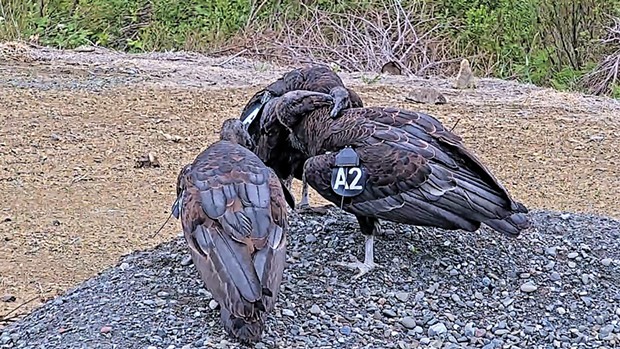
- Photo courtesy of Matt Mais/Yurok Tribe
- A2 gathers with A3 and A0 in the outside release area.
The first to take flight was A3, a nearly 2-year-old male that has been nicknamed "Poy'-we-son," which translates in the Yurok language to "the one who goes ahead," but is also the traditional name for a headman of a village, who helps lead and guide the village in a good way, according to Williams-Claussen.
He was followed shortly after by A2, another male that was given the name "Nes-kwe-chokw,'" which translates to "He returns" or "He arrives," which Williams-Claussen described during the duo's May 11 release as representative of "the historic moment we just underwent."
On May 25, the sole female, A0, joined the group, with Williams-Claussen choosing to call her "Ney-gem' 'Ne-chween-kah," which she describes as a "heavy name" that means "She carries our prayers."
The last of this first flock, A1, another young male, is scheduled to make his out-of-enclosure debut next month, delayed by a faulty satellite transmitter that needs to be replaced.
The staggered releases allowed the NCCRP team — a partnership between the Yurok Tribe, Redwood National and State Parks and other agencies — to monitor how the condors are adjusting to their new surroundings, while also encouraging those now flying free to regularly return to the management and release facility, with the birds still in the enclosure helping to provide a "social draw."
Chris West, the tribe's reintroduction program manager who brings decades of experience to the Yurok effort, says there are no specific protocols on exactly when to allow the young birds to take their first flight in the wild.
"It's hard to nail down what it is we are looking for," West says, noting it's more of a "gut" feeling.
Unlike chicks in the wild, many of those born in breeding facilities are separated from their parents at around 10 months, instead of the normal two years. This allows the captive mating pairs to produce an egg annually — one of many methods being employed by the restoration effort to increase the population.
That means this cohort of young condors didn't get to spend as much time learning the important life skills needed to thrive in the outside world, which is where No. 746 comes in, enacting discipline as needed and teaching them what it means to be a condor, including how to live in a highly social but hierarchical flock.
"He's pretty tolerant. You want balance in a mentor," West said, noting there were times he wished No. 746 was a little firmer with the young birds he'd taken under his wings, especially when they strayed from normal behaviors.
Ultimately, the goal of the recovery effort is to allow the condor to build up self-sustaining populations that no longer need to have their numbers boosted by releases from breeding programs and to reach the status West has described as "birds without tags," living their lives without human intervention.
While the Humboldt County site will hopefully act as a gateway for the birds to branch out into the Pacific Northwest, things here are likely to get off to a slow start, at least on the breeding side.
First of all, none of the birds is ready yet. Late bloomers in the avian world, condors don't mature until 7 or 8 — yet another obstacle in the species' ability to rebound — and the young ones being released are still some five years away from adulthood.
And even when that milestone is reached, it will likely take the condors a bit of time to figure out the logistics of mating without any adults around to show them the ropes, West says, likening the situation to the movie Blue Lagoon.
What's been observed at other new release sites is that eventually one of the pairs will connect the dots and, once it clicks, other pairs will follow suit, he says.
"They don't have a flock to meld into, so it's going to be a tough world for them," West says.
For the foreseeable future, the idea is to keep them returning to the release site perched on the edge of a rolling prairie in Redwood State and National Parks, so they can be monitored and taken in for regular exams to make sure the birds are healthy and their transmitters are functioning.
"That's part of the reason that the mentor bird is going to be staying with us for a little while, to keep them cued into who they consider to be the dominant bird in their hierarchy right now," Williams-Claussen says, noting the wildlife team is still providing regular feedings of carrion to those on the outside "to make sure they continue to be supported while they're figuring out their new landscape."
All three have already ventured out.
In fact, A3 took off right out of the gate, setting off on a two-week sojourn right after his release that included a stop on the Klamath River before finally making his way back to the site.
When he returned into view, A2 took flight to meet him before the two once again settled down amid the protection of the release site, which is encircled in a 1,600-foot electrified fence, measuring some 12-feet tall, to provide the birds additional security from potential predators, including mountain lions, with a small pool for the condors to bathe in.
A June 18 update from NCCRP notes that A2 and A3 have formed a particularly close bond and can often be seen preening, cuddling and roosting together.
Since their release, both have made significant progress in mastering how "to read the wind and adjust their bodies to capture and use the air to their advantage," according to NCCRP team.
"As they get older and more familiar with the region, they will fly off for weeks to months at a time, so we're all enjoying this time that we have to watch them so closely," the update states.
A0, however, is having a more difficult time, sticking close to the release site initially. Consequently, she hadn't honed her flying skills before setting out and had been gone for more than a week as of June 20.
The update states satellite data from A0's transmitter shows she's in a very remote area that's difficult for the NCCRP team to access to visually assess how she's doing.
"Remember that condors are large soaring birds that don't flap their wings very much when they fly," the updates states. "Because of this, it takes considerable time after release (or fledge) to learn how to remain aloft and be controlled in flight."
Each release site has to go through this same period, Williams-Claussen says, sending birds out into an environment devoid of condors to set the stage for those that will follow.
Come late summer or early fall, these trailblazers will be joined by a new batch of captive-raised fledglings, a process that will be repeated each year for at least the next two decades.
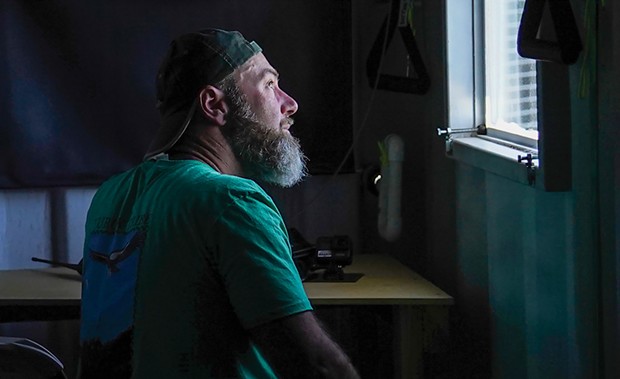
- Photo courtesy of Matt Mais/Yurok Tribe
- Chris West, the condor restoration project manager, views the birds through an observation window in a converted storage container that sits adjacent to the condor enclosure.
"We're going to want them to interact with the new birds coming in, both for the new cohort and for the now older birds' sake, so they can start forming a cohesive unit together and the young ones can watch how the wild birds are acting and interacting as well," Williams-Claussen says.
Getting to this point has already been a long road, with the tribe reaching out to local landowners — both public and private — as well as federal and state agencies, including U.S. Fish and Wildlife, which leads the California Condor Recovery Project with more than a dozen partners, to establish a collaborative effort.
The Yurok Tribe's wildlife team also spent more than a decade laying the groundwork for the birds' return by mapping potential habitat, working to educate hunters about non-lead ammunition options and trapping fellow scavengers — turkey vultures and ravens — to test their blood for lead exposure from tainted carrion, which is the single greatest threat to condors' survival in the wild.
Other prep work included the sampling of marine mammals to check for toxins that could impede the flocks' success.
Known as the clean-up crew of the wild, condors play an important role in the ecosystem as apex scavengers that use their powerful beaks to pierce the tough skins of dead animals ranging from elk to sea lions and even the occasional whale, clearing the large carcasses from the landscape and helping to prevent the spread of disease.
"It's been a 14-year journey ... with a lot of successes, a lot of pitfalls, a lot of people coming together to overcome complexities in order to bring condors back in an integrated way that will benefit the species but also benefit the region," Williams-Claussen says.
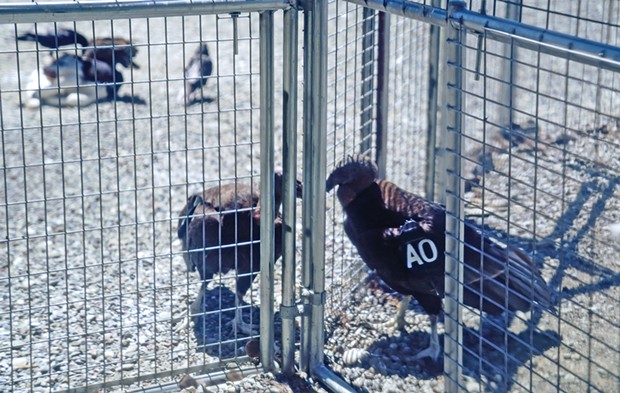
- Photo courtesy of Matt Mais/Yurok Tribe
- One of the condors interacts with A0 through the enclosure before her release.
As a tribal member, she says, a number of things stand out.
"One is that this ... is a good example of how the Yurok Tribe is taking back the power and authority to be caretakers of the landscape," Williams-Claussen says. "We've always maintained that responsibility and obligation, but it's hard to do when your lands have been taken away from you."
Another, she says, has been her ability to learn more about what it means to be a World Renewal person by working with the tribe's elders and the community, as well as what it means to be a part of such a large conservation effort that "has been going on for decades and decades, of course, with innumerable partners coming together to make it happen."
"And, just as a final tap on that," Williams-Claussen continues, "I myself have grown and learned from my opportunity to work with my elders on this, which has brought healing to me and my family. But then it's also something I'm passing on to my daughter, who just turned 4 and who loves condors in a way I didn't even know to love condors when I was a kid because they had been absent so long. And they are just a natural part of her life now, so that's been really impactful to me as well."
But sending condors out into the larger world comes with inherent risk — mainly from man-made threats, including lead poisoning and electrocution by power poles. Asked if it was hard not to become attached to the birds, Williams-Claussen says it's already too late.
"On the one hand, you kind of want to tell yourself not to because, unfortunately, condor mortality is very high in the wild and it's fully expected that we're going to be losing some of our birds," she says. "But on the other hand, it's impossible not to be attached, especially after waiting for them for so long,"
She notes that this project has been in the works for 14 years and "our region has been waiting for condors to come back for 130." Any losses, she says, are "something we are going to have to navigate."
"Personally, I want to maintain that attachment," Williams-Claussen says. "I think that's what is needed to ... help them thrive, to bring the world back into balance in a way so that it can support them again, which is not where we are right now. But it takes that attachment, it takes that love and that drive of not just us but everybody that's committed to condor restoration to make things really happen.
"So I think it's going to end up hurting but it's incredibly important to have that attachment anyway," she says.
Kimberly Wear (she/her) is the Journal's digital editor. Reach her at 442-1400, extension 323, or [email protected]. Follow her on Twitter @Kimberly_Wear.
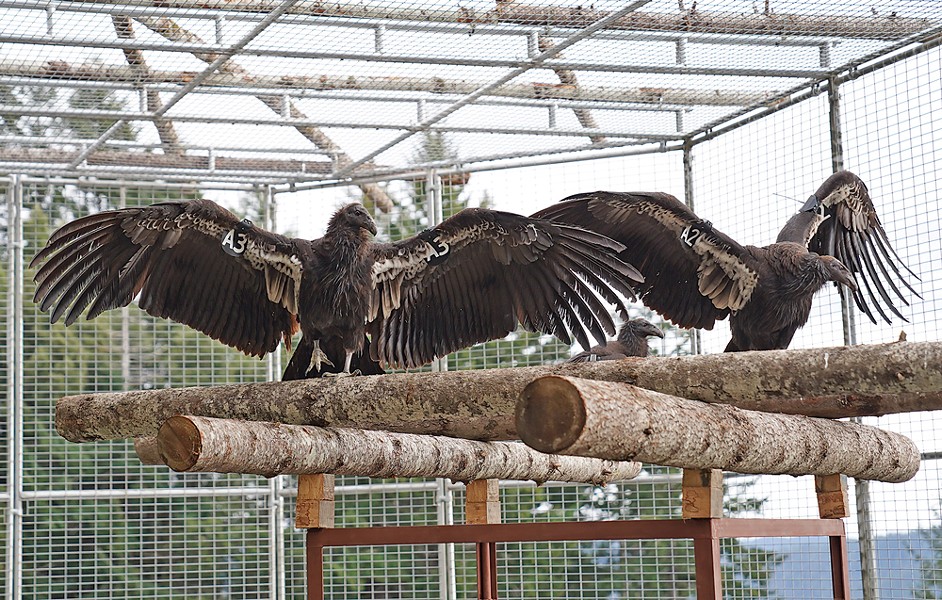

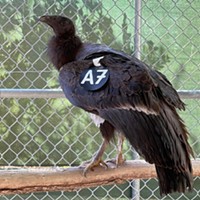

Comments